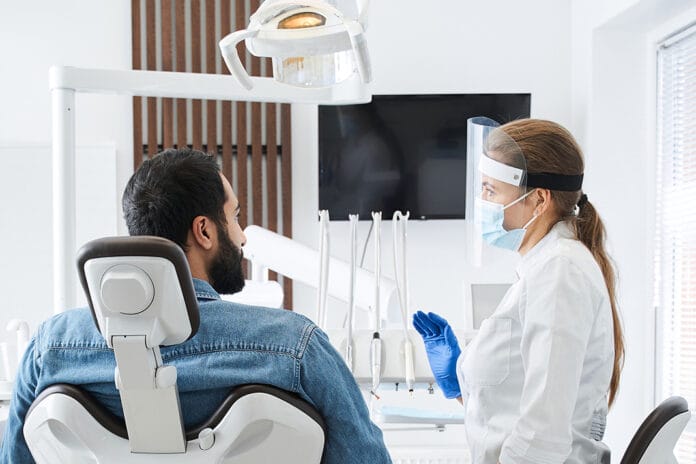“Floss more and brush better.” This is the dreaded advice patients expect to get scolded with every six months. How many times have we sat there and discussed the benefits of interdental cleaning and demonstrated how to brush? Let’s step back and remember what it was like for us before we became oral health preventative specialists.
A patient would show up for a dental hygiene appointment and get called back, all while thinking about how to answer the flossing question and hope it doesn’t hurt as much this time. After pleasantries, the pop quiz begins. Someone lays you back to where it feels like you are upside down, and he or she immediately gets into your personal bubble, sticking their fingers into the mouth, all while quizzing you about brushing and flossing habits.
The hygienist would start poking the gums for a while, and when the bleeding starts, he or she would ask if you are really flossing and brushing as claimed. It is stressful, and the patient feels like you are never doing enough, leaving with the promise, “Thank you. I know. I will try better for next time.”
For those patients who have always had a “good” report at dental appointments, it may be harder to relate. But, remember, the dental office can be a very stressful place for many people. We are here to help alleviate that stress, creatively educate on an individual basis, and coach our patients to health.
With compressed schedules and production goals, it is easy to become short and to the point, especially with some of our more challenging, less compliant patients. Step back. Take a breath. Get back to basics. We need a facelift for our old advice to hopefully get patients more engaged.
Not All Toothbrushes are Created Equal
Let’s first start off by asking what type of toothbrush they use. No matter what the answer is, be encouraging. If someone says, “I use just a regular toothbrush, but I like the hard bristles,” answer with something positive first.
“Excellent, a lot of people feel the same way. Back in the day, we thought that was the best. Now we know that brushing with a softer brush but for a longer time is not only better for your teeth and gums, but they actually clean better too.”
Or a patient may say, “I have an electric one, but sometimes it’s just easier to use the regular one. It just feels cleaner.”
This one opens up a couple of avenues. Which electric toothbrush are they using? By “easier,” do they mean it doesn’t have a timer, so it takes less time to just use the regular one? Are they having an issue giving up control to the electric toothbrush because they are an aggressive brusher, and you now have a discussion about recession? Sitting back and listening to them and then asking clarifying questions gets them engaged and more likely to remember the conversation. Using phrases such as, “Many have felt this way,” or “You are not alone” puts patients at ease and makes them more comfortable to continue opening up.
Now you have started with a positive vibe instead of immediately telling them, “You are wrong.” Get them involved in the process by asking open-ended questions. Steer the conversation to get them involved and asking questions such as, “Is there something better I should use?” By helping them interact more, they will be more likely to feel that they are part of the discussion instead of the recipient of a biannual lecture.
Floss? I Do It Every Time I’m Here
Patients will often say, “I just really hate flossing. I know you’re going to yell at me.” How often have we heard that? Going to the dentist is not high on most people’s list of entertainment options (although we do get a few exceptions).
Our job is to encourage and gently coach our patients. Instead of asking if they floss, ask them what they normally use to clean between their teeth and how often they feel successful in doing it with their approach. By asking open-ended questions and using positive language, our patients may feel less defensive.
The open-ended questions should also help patients feel that they can be honest with us by reminding them they are not alone and offering up suggestions that have helped others in the past. This allows us to point out the flaw in their current routine in a low-key way while offering up some alternative solutions so they don’t feel discouraged but empowered.
Do we want patients to clean between their teeth every day? Of course, we do! In this day and age, we are blessed to have so many choices other than just a piece of string. Get to the root of the problem. Ask them what they think discourages them. Is it too difficult? Are they too tired at the end of the day? Does it hurt when they do? Does it get stuck and break? Do they flat out just say that they are too lazy?
Getting them involved helps you brainstorm together. Remind them that they are not alone. According to a survey taken in 2017, “only sixteen percent [of patients] said they always floss at least once a day.”1
Being creative and looking outside the box is vital to their success. Make suggestions such as keeping floss (or whichever interdental cleaner works best for them) by their computer for convenience, flossing when their kids do for accountability, and cleaning in between their teeth after lunch still counts as once per day.
All of these suggestions have helped my patients be successful. I have had many patients come in, excited to tell me about how they have been flossing more because this was something that changed their view and worked with their routine.
Discuss alternative interproximal aids such as interdental brushes or shower oral irrigators. These are all tools our patients may not have known existed and could be a game-changer. Communicating with positive and encouraging language gets them more involved instead of, “Just floss the teeth you want to keep” (not that we say this, but that is what they hear, am I right?).
I Use Mouth Rinse Sometimes, But Does It Really Do Anything?
We possess a wealth of knowledge, and it is our job to help our patients navigate the grocery store aisle. There are new products with all of the buzz-words such as “anti-cavity,” “fresh breath all day long,” or “whitens three shades in a week.” If it has been a while, go down the oral care aisle and see what’s new, or hop onto Amazon for a little research. Reach out to oral care company reps for lunch-and-learns. Our patients need assistance pinpointing specific benefits from the products they purchase for bacterial management, fluoridation, or dry mouth relief, for example.
Get the patient involved in what you observe. “The medications you are taking commonly cause dry mouth; I am noticing a decrease in your saliva. Were you aware of this?” Hand the patient a mirror prior to treatment so they can see areas of concern (red or bleeding gingival, biofilm/calculus buildup, color changes in the teeth). Show them where they are doing well vs. challenging areas, so they know what health looks like. Co-discovery will increase self-awareness and take some of the anxiety away. It is overwhelming for us sometimes, let alone for our patients, to make an informed decision. We are there to help bridge the gap. Also, this opens up other discussions, such as xerostomia and proper nutrition.
What we do clinically is important but setting our patients up for success between appointments is paramount. With our abundance of information yet the limited time with them, it is important to streamline where we can but still make each experience personalized. If they are engaged and encouraged on their departure, instead of feeling discouraged, they will be more likely to want to return and bring their loved ones there too.
Need CE? Check Out the Self-Study CE Courses from Today’s RDH!
Listen to the Today’s RDH Dental Hygiene Podcast Below:
Reference
- New Survey Highlights ‘Unusual’ Flossing Habits. (2017, October 20). American Dental Association. Retrieved fromwww.ada.org/en/publications/ada-news/2017-archive/october/new-survey-highlights-unusual-flossing-habits












